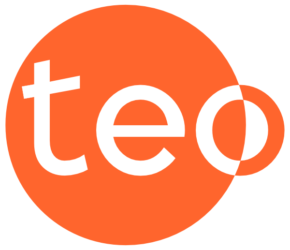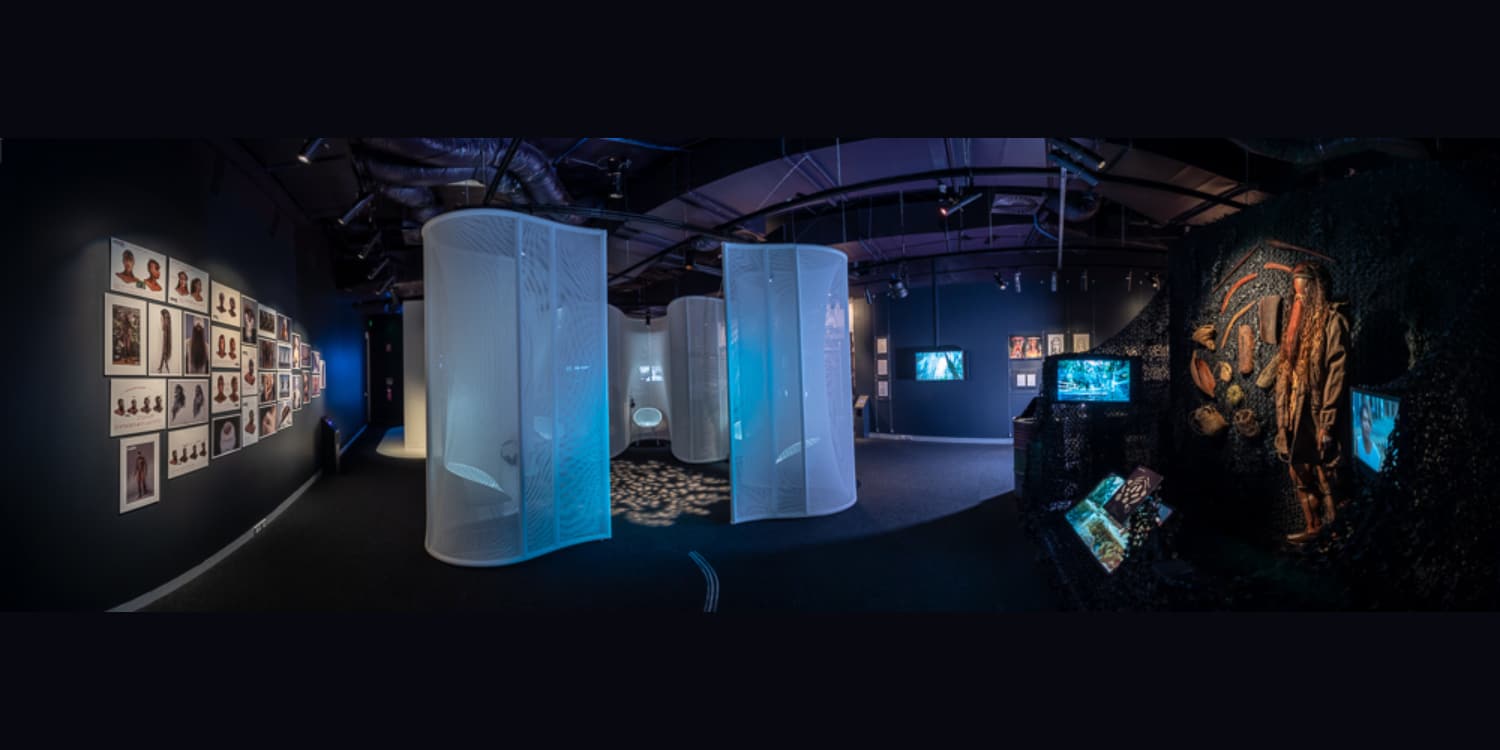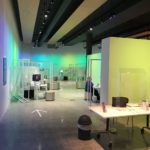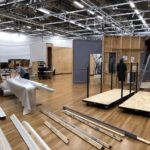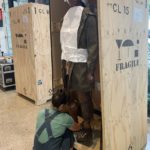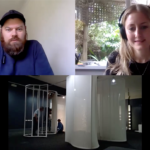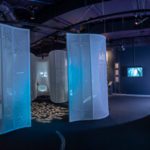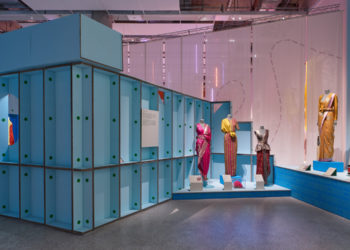Setting the scene
20th March 2020. We are at Wellington airport, anxiously waiting to board one of the last flights out of New Zealand. Over the past ten days we had been deinstalling ACMI’s Wonderland exhibition at the Museum of New Zealand Te Papa Tongarewa.
During our time away from home, we watch in horror as COVID-19 cases are increasingly confirmed around the world, including Australia and New Zealand. Away from loved ones on 11 March, the WHO declares COVID-19 as an official pandemic. Europe begins to lock down, and strict entry and quarantine measures for travelers into New Zealand are imposed. Our specialist technician and European based couriers are no longer able to join us.
With our incredible colleagues at Te Papa, we manage to dismantle most of the exhibition – before we have to get out – and get home. Within four days, New Zealand and Australia are in full lockdown.
Once home and in quarantine for 14 days, the full impact of what we had just experienced began to sink in. All our international exhibitions were grounded. Thankfully two of our shows were already back in Melbourne, but it would not be until June that Wonderland could safely return home.
Impact
With Australia in lockdown and all borders closed, our national programme also suddenly stopped. Cleverman, our newest touring exhibition had just opened at The Main Corner Complex, Mount Gambier, SA, only to close six days later. Code Breakers, on show in Bendigo’s Discovery Science and Technology Centre had to suddenly be deinstalled, whilst Nightingale, was luckily already on display at New England Regional Art Gallery, NSW.
With the pandemic so widespread and the impact and duration of the lockdown still unknown, our first step was to connect with host venues, offering support, assistance and reassurance.
With the pandemic so widespread and the impact and duration of the lockdown still unknown, our first step was to connect with host venues, offering support, assistance and reassurance.
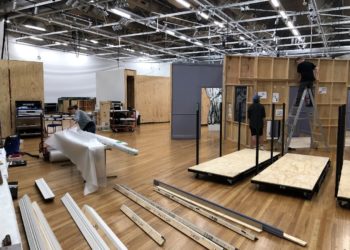
Analysis of Risk
The next critical step was to review and assess the risks associated with delivering a touring programme during a COVID-19 pandemic. Our priority focus was on our national programme which we surmised would recommence well before the international one. All key activities and risks were identified, analysed and evaluated in relation to ACMI organisational and Victorian Government protocols, with the prioritisation of staff health, safety and wellbeing. Throughout all pandemic stages, information and government advice rapidly changed, on both national and state levels, and continued to do so. It was essential therefore that our procedures remained ‘live’ to reflect current and everchanging requirements.
Exhibition review and COVID-19
As all our national exhibitions were created and designed pre-COVID and featured integrated interactive elements, each needed to be assessed in terms of their COVID safety. Key areas of focus have been cleaning and hygiene, safe use of technology and interactives, identifying active touch points, ensuring audience comfort and continued active engagement with our exhibitions.
During this review process we consulted widely with current and future host venues, seeking input, information and feedback. Through these discussions, we learnt there was no single solution, with venues and states having different degrees of flexibility and adaptability around how to mitigate COVID-19 risks within exhibitions and cultural environments. These local parameters and protocols were also rapidly evolving and adapting, with host venues having to respond quickly and creatively to government advice, often with limited lead times and resources.
The resulting outcome was threefold:
- Where possible, we adapted individual exhibition elements to eliminate as many risks as possible.
- For exhibition elements assessed as being in a ‘risk category’, we offered flexible delivery and/or engagement alternatives, enabling presenters the option to select their own level of risk in relation to these elements, and
- The option for remote exhibition delivery for installation and demount
Note: all ACMI exhibitions are normally accompanied by specialist crew who work with host venues and local staff to install/deinstall our exhibitions.
Action
With the proposed outcomes now identified, the next step was to reactivate the programme and to enable smooth delivery. ACMI Touring swung into gear with colleagues from Touring, Registration and Exhibitions AV working together to deliver these changes. Key activities included:
- Revising all core exhibition documentation, ensuring material was clear and accessible to presenters and with a re-focus on the perspective of an external user,
- Revising schedules and activity sequencing to meet new remote delivery requirements, and
- Establishing new means of communication and information sharing to facilitate remote delivery and instruction
Case study 1: Code Breakers: Women in Games
Our first remote delivery was deinstalling Code Breakers at the Discovery Science and Technology Centre, Bendigo. This activity happened not long after COVID-19 lockdowns came into effect in Melbourne, so no staff could travel. The lead time for this deinstall was sudden and at the request of the venue, so the team had to work quickly and creatively to prepare for its first remote delivery.
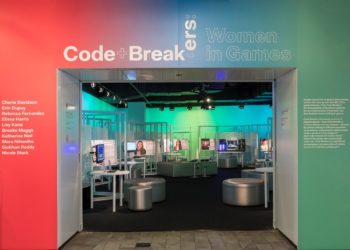
The priority was to rework all manuals and support documentation to be more user friendly and accessible for non-tech users.
As Code Breakers consists of furniture and AV content only, the priority was to rework all manuals and support documentation to be more user friendly and accessible for non-tech users. The original manuals had been created for ACMI crew use only (staff who would usually accompany the exhibition) so all documentation had to be adapted to the perspective of an external user. It also proved challenging to extract and distill years of acquired organisational knowledge about this exhibition into something comprehensible and accessible for host venues.
As the ‘trial run’ for remote delivery, Code Breakers was almost the ideal project. With no art objects requiring specific management and logistics, the dismantling of technology and furniture was relatively straightforward. Our confidence was further supported by the fact that we knew the local crew, the crew knew the show and it would be the same staff from the installation.
With this being our first remote attempt, we revised the schedule and sequencing of activity to allow for a slower pace. Furniture and AV deinstall tasks were staggered as opposed to running concurrently, allowing for a more focused and supported process. This slowing down, invariably added an extra day to the demount schedule, but the additional time was required.
The primary onsite communication and support tool used was video conferencing via Zoom. Regular morning and afternoon briefings were scheduled, covering key tasks set for each period of activity. In addition, for more complex elements, specific briefings were scheduled, so that information could be delivered in ‘bite-sized’ chunks, allowing the ACMI team opportunity to highlight any particular ‘tricks’ or instructions. As this was our first remote attempt, we quickly learnt what worked and what we could improve upon for future venues.
Running parallel to this was our internal COVID assessment of Code Breakers, an exhibition showcasing the work of ten female game designers. With each maker having their own dedicated station with playable games, the essence of this show is active audience interaction, so the physical adaptations we could realistically enable were minimal.
In light of COVID, we want to ensure our audiences continue to interact with the exhibition, but to also feel comfortable and safe doing so. We consulted future partner venues to gauge responses to hosting such an interactive exhibition, as well as feedback concerning changing audience behavior and comfort levels. Resulting modifications included offering venues the option to reduce the number of interactive iPads, touch screens and headsets, in addition to providing content via a QR code, for audiences to access on their own devices.
We want to ensure our audiences continue to interact with the exhibition, but to also feel comfortable and safe doing so. We consulted future partner venues to [...] [gain] feedback concerning changing audience behavior and comfort levels.
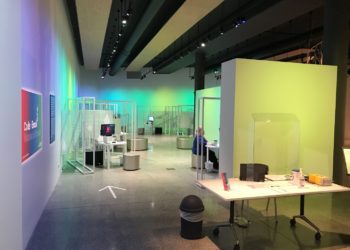
Despite the high interactivity of Code Breakers, we discovered venues and audiences remain committed to hosting and engaging with such a ‘tactile’ exhibition. The resulting focus was therefore to maximise hygiene and actively meet changing audience comfort levels. In consultation with ACMI, each venue is responsible for implementing their own strict cleaning regimes in line with local COVID protocols, coupled with reduced visitation numbers and staggered entry times. Audiences also have the option to ‘self-clean as they go’, with hygiene stations readily available at exhibition entry and exit points, and disinfectant wipes and hand sanitiser available at each game station.
Case study 2: Cleverman
Our newest touring exhibition Cleverman, proved to be more challenging.
Cleverman had just opened at The Main Corner Complex in Mount Gambier, SA in early March, only to close six days later, as Australia headed into complete lockdown. The full impact of COVID on this exhibition’s touring schedule unfolded dramatically over the next few months, with sadly some venues having to withdraw because of the financial impact of the pandemic.
With Cleverman in lockdown in South Australia we used the time available to rework the entire tour schedule. We also undertook our internal exhibition COVID assessment, to enable a safe reopening at Mt Gambier and then at subsequent venues.
Cleverman explores First Nations storytelling, mythology, language and creativity through the lens of Australia’s critically acclaimed Indigenous superhero TV series, Cleverman. Visitors are welcomed into the Bindawu Spirit Tree listening space, to hear the key Dreaming stories underpinning the series, and to explore behind-the-scenes interviews with cast and crew, view original artwork, props and video content. The exhibition design therefore centres around an oral and visual visitor experience, with voice recordings instead of printed label text, and multiple screens delivering film content via headphones.
Our approach in this instance was to offer tiered options to venues, ranging from no changes through to reversible adaptations that could be applied to the original design and curatorial intent, and in response to the evolving impact of COVID. These adaptations centre around reducing touch points and maximising social distancing opportunities which host venues could match to local cleaning, hygiene and access protocols, and varying audience comfort levels in relation to interactivity. Strategies offered include: using printed labels instead of audio versions (which require a touch button to activate,) fewer listening stations to allow for better social distancing (including within the Bindawu Spirit Tree) and reduced headphones per screen coupled with the installation of accessible headphone jacks. This allows visitors the option of being issued with their ‘own headphone’ for use throughout their visit, or to bring their own.

[We] offer[ed] tiered options to venues, ranging from no changes through to reversible adaptations that could be applied to the original design and curatorial intent, and in response to the evolving impact of COVID.
Adapting this exhibition to match a new COVID world, whilst retaining the original curatorial and design intent was challenging. Cleverman is a complex exhibition to tour. It is large in scale, multilayered, and includes a wide range of fragile art objects, props, furniture, large scale graphics, and complex technology. It is intricate to install and demands close collaboration, sequencing and input from ACMI Touring, Registration and Exhibition AV teams.
The learnings from the Code Breakers remote experiences were invaluable when applied to the context of Cleverman, but the complexity and size of this exhibition required further adaptations. This included more frequent Zoom briefings as well as identifying key tasks/activities necessitating ‘live’ Zoom instruction by the ACMI team. The schedule was again slowed down to match remote delivery requirements, but the complex layering of various exhibition elements made it impossible to cleanly separate and stagger activities across the three key areas of: art, furniture/props and AV.
The nature of this exhibition and its design mean install/deinstall activities have to occur concurrently. To enable an efficient delivery within the tight schedule, dedicated teams across the three areas are required, each with an assigned ACMI and local lead. This requires open and active communication between ACMI and the host venue and a clear schedule of activity ensuring tasks can be completed onsite safely and as per ACMI requirements. The complexity of Cleverman also demanded a more detailed reworking of existing documentation and manuals and a comprehensive install/deinstall kit. Key documents were shared online via SharePoint, ensuring all core information was consolidated by activity, linked back to the schedule and communicated as clearly as possible to host venues and key staff.
What we have learned
Despite the ongoing uncertainties and challenges COVID continues to present, the journey we have embarked upon to adapt our exhibitions and delivery mode from a singular ‘physical and onsite focus’ to one that can be undertaken remotely, has proved invaluable. With each new remote activity, we continue to adapt and evolve how we deliver our exhibits, to ensure we have the ongoing capacity to deliver unique exhibition experiences to Australian and international audiences.
On a national level, this flexible touring model has allowed us to adapt existing exhibition content and modes of presentation, so that we can continue to operate effectively but with greater responsiveness to ever-changing circumstances. These adaptations do not come without challenges. Like most museums and galleries, our model to date has prioritised ACMI crew traveling to host venues and working with local staff. We have a duty of care to lenders, partners and insurers, and an ongoing responsibility to certify that our exhibitions remain in ‘pristine’ condition for current and future host presenters.
These responsibilities have been most tested by the remote delivery model. Not being able to physically see, handle and check each exhibition item leaves us exposed to the possibility and uncertainty of not being able to guarantee future venues with exhibitions that are in excellent condition and working order. Similarly, the shift to remote delivery increases the pressure and onus on host venues to install, demount, repack and check each exhibition element as per ACMI’s specific requirements.
Reciprocal trust and open communication remains vital, so as to enable the striking of this fine balance between virtual and physical, instruction and autonomy.
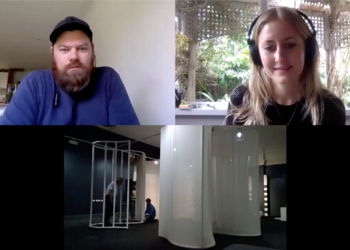
The successful delivery of an exhibition requires collaboration and open dialogue between the presenter/venue and organiser/lender. Regardless of COVID, we have continued to undertake all initial exhibition preparation, planning and scheduling remotely. This has remained unchanged. But it is the ‘onsite’ face to face interactions at host venues that help strengthen new relationships and partnerships. Trying to do so via Zoom, Slack, Teams, Skype or Google hangouts is just not the same.
Remote delivery places pressure on both parties. For all, there is the ‘video call fatigue’ and frustration with poor Wi-Fi or insufficient devices to enable effective communication. For the organiser/lender, anxiety about not being physically present, inability to effectively trouble shoot onsite with local crew and assurances the exhibition is systematically being unpacked, checked and installed as required (with the reverse for demount), guaranteeing an intact product for our next host venues. For the presenter, frustration regarding a somewhat slower pace, remote and perhaps unwelcome supervision and oversight and a general disruption to usual processes and working methods.
Our experiments with remote delivery reinforce that open communication, collaboration, flexibility and empathy, trust and managing expectations remain key. For ACMI, remote or ‘virtual’ delivery was never designed to ‘replace’ or be ‘instead of’ physical onsite presence and participation by our team. For presenters however, the detailed manuals and documentation we now provide may be perceived as fully replacing the need for ACMI involvement. Hence reciprocal trust and open communication remains vital, so as to enable the striking of this fine balance between virtual and physical, instruction and autonomy.
Our journey into the realms of remote delivery is by no means over. Since commencing in March, we have welcomed and encouraged feedback from our touring partners across all areas of remote delivery and continue to adapt and modify ‘what and how we do’ to match context and needs. This new model has also created opportunities. Remote delivery increases our flexibility of offer, and our intention once borders reopen is for this aspect to remain a key element of our delivery model option. In addition, accompanying touring public programmes and education packages previously available only as physical activities, have now pivoted into virtual delivery, increasing accessibility for presenters and audiences and reducing costs.
We remain grateful to all our touring partners for their ongoing support and creative energy as we continue to collaborate, explore and adapt to new ways of working. We are now well underway to apply these learnings to our international travelling exhibitions.
This article was originally published on ACMI Labs on 17 November 2020.
Exhibitions mentioned
Wonderland, by ACMI
Del Kathryn Barton: The Nightingale and the Rose, by ACMI
Code Breakers: Women in Games, by ACMI
Cleverman, by ACMI
